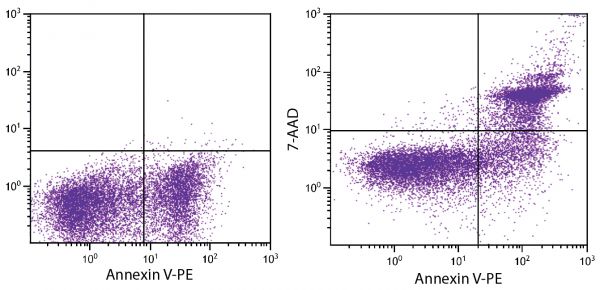ApoScreen® Annexin V Apoptosis Kit-PE
Cat. No.:
10010-09
PE ® Annexin V Apoptosis Kit for use in flow cytometry assays.
$286.00


| Description | ApoScreen® Annexin V Apoptosis Kit-PE (SB Cat. No. 10010-09) employs a R-phycoerythrin-conjugated Annexin V (Annexin V-PE) in concert with 7-Aminoactinomycin D (7-AAD) to evaluate subpopulations of cells undergoing apoptosis. During the early stages of apoptosis, cells begin to display phosphatidylserine (PS) on the outer cell membrane where it is readily detectable by staining the cells with Annexin V-PE. As the plasma membrane becomes increasingly permeable during the later stages of apoptosis, 7-AAD can readily move across the cell membrane and bind to cellular DNA, providing a means for identifying those cells that have lost membrane integrity through mechanisms including necrosis. When cells are double stained with Annexin V-PE and 7-AAD, three different cell populations may be observed - (i) live cells that do not stain with either Annexin V-PE or 7-AAD; (ii) necrotic cells that stain with both reagents; and (iii) apoptotic cells that stain with Annexin V-PE only. Analysis may be performed on any flow cytometer equipped with a single laser using excitation at 488 nm. |
|---|---|
| Conjugate | PE (R-phycoerythrin) |
| Buffer Formulation | Annexin V-PE - Phosphate buffered saline containing < 0.1% sodium azide and a stabilizer 7-AAD - Phosphate buffered saline containing < 0.1% sodium azide Annexin Binding Buffer - Contains 0.1% sodium azide and proprietary ingredients |
| Volume | 1.0 mL |
| Recommended Storage | 2-8°C; Avoid exposure to light; Do not freeze |
| Kit Components |
Annexin V-PE - 1.0 mL 7-Aminoactinomycin D (7-AAD) - 1.0 mL Annexin V Binding Buffer 10X - 7 x 1.5 mL |
| Trademark Information | ApoScreen® is a registered trademark of Southern Biotechnology Associates, Inc. |
| Applications |
Flow Cytometry – Quality tested 1-35 |
Documentation
Certificate of Analysis Lookup
Enter the Catalog Number and Lot Number for the Certificate of Analysis you wish to view
- 1. Schwartzenberg S, Deutsch V, Maysel-Auslender S, Kissil S, Keren G, George J. Circulating apoptotic progenitor cells: a novel biomarker in patients with acute coronary syndromes. Arterioscler Thromb Vasc Biol. 2007;27:e27-31. (FC)
- 2. Ben-Shoshan J, Maysel-Auslender S, Mor A, Keren G, George J. Hypoxia controls CD4+CD25+ regulatory T-cell homeostasis via hypoxia-inducible factor-1α. Eur J Immunol. 2008;38:2412-8. (FC)
- 3. Qian C, Yan W, Zhang J, Shi L, Qian J, Fu Z, et al. Notch1 induces enhanced expression of Δ-like-1 in the U251MG glioma cell line. Int J Mol Med. 2009;24:445-51. (FC)
- 4. Hsieh C, Hernández-Ledesma B, de Lumen BO. Lunasin, a novel seed peptide, sensitizes human breast cancer MDA-MB-231 cells to aspirin-arrested cell cycle and induced apoptosis. Chem Biol Interact. 2010;186:127-34. (FC)
- 5. Yan Y, Zheng M, Chen Z, Yu X, Yang X, Ding Z, et al. Studies on preparation and photodynamic mechanism of chlorin P6-13,15-N-(cyclohexyl)cycloimide (Chlorin-H) and its antitumor effect for photodynamic therapy in vitro and in vivo. Bioorg Med Chem. 2010;18:6282-91. (FC)
- 6. Li W, Li Y, Guo J, Liu Y, Yang X, Ge H, et al. Hepatocytic precursor (stem-like) WB-F344 cells reduce tumorigenicity of hepatoma CBRH-7919 cells via TGF-β/Smad pathway. Oncol Rep. 2010;23:1601-7. (FC)
- 7. Jung C, Rafnsson A, Shemyakin A, Böhm F, Pernow J. Different subpopulations of endothelial progenitor cells and circulating apoptotic progenitor cells in patients with vascular disease and diabetes. Int J Cardiol. 2010;143:368-72. (FC)
- 8. Yan F, Tan X, Geng Y, Ju H, Gao Y, Zhu M. Inhibition effect of siRNA-downregulated UHRF1 on breast cancer growth. Cancer Biother Radiopharm. 2011;2:183-9. (FC)
- 9. Yao K, Wang W, Zhu Y, Jin C, Shentu X, Jiang J, et al. A novel GJA3 mutation associated with congenital nuclear pulverulent and posterior polar cataract in a Chinese family. Hum Mutat. 2011;32:1367-70. (FC)
- 10. Hsieh C, Hernández-Ledesma B, de Lumen BO. Cell proliferation inhibitory and apoptosis-inducing properties of anacardic acid and lunasin in human breast cancer MDA-MB-231 cells. Food Chem. 2011;125:630-6. (FC)
- 11. Shi X, Su S, Long J, Mei B, Chen Y. MicroRNA-191 targets N-deacetylase/N-sulfotransferase 1 and promotes cell growth in human gastric carcinoma cell line MGC803. Acta Biochim Biophys Sin. 2011;43:849-56. (FC)
- 12. Li X, Guo Q, Wang X, Xue B, Sun L, Meng Q, et al. LRP16 gene protects mouse insulinoma MIN6 cells against fatty acid-induced apoptosis through Akt/FoxO1 signaling. Chin Med J. 2012;125:1695-1702. (FC)
- 13. Zhang Y, Du X, Wang C, Lin D, Ruan X, Feng Y, et al. Reciprocal activation between PLK1 and Stat3 contributes to survival and proliferation of esophageal cancer cells. Gastroenterology. 2012;142:521-30. (FC)
- 14. Ma Y, Jiang J, Wang L, Nie H, Xia W, Liu J, et al. CD38 is a key enzyme for the survival of mouse microglial BV2 cells. Biochem Biophys Res Commun. 2012;418:714-9. (FC)
- 15. He X, Nie H, Hong Y, Sheng C, Xia W, Ying W. SIRT2 activity is required for the survival of C6 glioma cells. Biochem Biophys Res Commun. 2012;417:468-72. (FC)
- 16. Choi YJ, Li X, Hydbring P, Sanda T, Stefano J, Christie AL, et al. The requirement for cyclin D function in tumor maintenance. Cancer Cell. 2012;22:438-51. (FC)
- 17. He X, Shao Y, Li X, Xu W, Chen G, Sun H, et al. Downregulation of miR-101 in gastric cancer correlates with cyclooxygenase-2 overexpression and tumor growth. FEBS J. 2012;279:4201-12. (FC)
- 18. Xu R, Lin F, He J, Jin L, Zhang J, Fu J, et al. Complement 5a stimulates hepatic stellate cells in vitro, and is increased in the plasma of patients with chronic hepatitis B. Immunology. 2012;138:228-34. (FC)
- 19. Xie W, Xie H, Liu F, Li W, Dan J, Mei Y, et al. Propranolol induces apoptosis of human umbilical vein endothelial cells through downregulation of CD147. Br J Dermatol. 2013;168:739-48. (FC)
- 20. Jung C, Rafnsson A, Brismar K, Pernow J. Endothelial progenitor cells in relation to endothelin-1 and endothelin receptor blockade: a randomized, controlled trial. Int J Cardiol. 2013;168:1017-22. (FC)
- 21. Wang Y, Guo R, Guo R, Sheng W, Yin L. MicroRNA-182 promotes cell growth, invasion, and chemoresistance by targeting programmed cell death 4 (PDCD4) in human ovarian carcinomas. J Cell Biochem. 2013;114:1464-73. (FC)
- 22. Li Y, Nie H, Wu D, Zhang J, Wei X, Ying W. Poly(ADP-ribose) polymerase mediates both cell death and ATP decreases in SIRT2 inhibitor AGK2-treated microglial BV2 cells. Neurosci Lett. 2013;544:36-40. (FC)
- 23. Humphries LA, Godbersen JC, Danilova OV, Kaur P, Christensen BC, Danilov AV. Pro-apoptotic TP53 homolog TAp63 is repressed via epigenetic silencing and B-cell receptor signalling in chronic lymphocytic leukaemia. Br J Haematol. 2013;163:590-602. (FC)
- 24. Zhu J, Hong D, Song Y, Sun L, Wang Z, Wang J. Suppression of cellular apoptosis susceptibility (CSE1L) inhibits proliferation and induces apoptosis in colorectal cancer cells. Asian Pac J Cancer Prev. 2013;14:1017-21. (FC)
- 25. Hong Y, Nie H, Wu D, Wei X, Ding X, Ying W. NAD+ treatment prevents rotenone-induced apoptosis and necrosis of differentiated PC12 cells. Neurosci Lett. 2014;560:46-50. (FC)
- 26. Chen X, Chen Y, Lan J, Shen Z. MicroRNA-370 suppresses proliferation and promotes endometrioid ovarian cancer chemosensitivity to cDDP by negatively regulating ENG. Cancer Lett. 2014;353:201-10. (FC)
- 27. Wang K, Ma J, Zhang F, Yu M, Xue J, Zhao J. MicroRNA-378 inhibits cell growth and enhances L-OHP-induced apoptosis in human colorectal cancer. IUBMB Life. 2014;66:645-54. (FC)
- 28. Godbersen JC, Humphries LA, Danilova OV, Kebbekus PE, Brown JR, Eastman A, et al. The Nedd8-activating enzyme inhibitor MLN4924 thwarts microenvironment-driven NF-κB activation and induces apoptosis in chronic lymphocytic leukemia B cells. Clin Cancer Res. 2014;20:1576-89. (FC)
- 29. Nie H, Li Y, Wang C, Chen X, Liu B, Wu D, et al. SIRT2 plays a key role in both cell cycle regulation and cell survival of BV2 microglia. Int J Physiol Pathophysiol Pharmacol. 2014;6:166-71. (FC)
- 30. Feng G, Zhang J, Zeng Q, Yu X, Zhang Z, Lv S, et al. Interleukin-21 mediates hepatitis B virus-associated liver cirrhosis by activating hepatic stellate cells. Hepatol Res. 2014;44:E198-205. (FC)
- 31. Wang C, Chen H, Zhang J, Hong Y, Ding X, Ying W. Malate-aspartate shuttle mediates the intracellular ATP levels, antioxidation capacity and survival of differentiated PC12 cells. Int J Physiol Pathophysiol Pharmacol. 2014;6:109-14. (FC)
- 32. Yao Y, Ma J, Wang P, Xue Y, Li Z, Zhao L, et al. miR-101 acts as a tumor suppressor by targeting Kruppel-like factor 6 in glioblastoma stem cells. CNS Neurosci Ther. 2015;21:40-51. (FC)
- 33. Wang C, Zhang J, Zhang M, Chen H, Ying W. Aralar plays a significant role in maintaining the survival and mitochondrial membrane potential of BV2 microglia. Int J Physiol Pathophysiol Pharmacol. 2015;7:107-114. (FC)
- 34. Paiva C, Godbersen JC, Berger A, Brown JR, Danilov AV. Targeting neddylation induces DNA damage and checkpoint activation and sensitizes chronic lymphocytic leukemia B cells to alkylating agents. Cell Death Dis. 2015;6:e1807. (FC)
- 35. Johnson RM, Vu NT, Griffin BP, Gentry AE, Archer KJ, Chalfant CE, et al. The alternative splicing of cytoplasmic polyadenylation element binding protein 2 drives anoikis resistance and the metastasis of triple negative breast cancer. J Biol Chem. 2015;290:25717-27. (FC)
See All References



